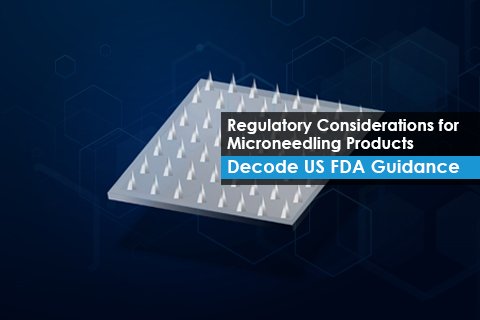In a recent development, the US FDA has released a new guideline to assist the microneedling device manufacturers understand the product classification, applicable regulations, registration pathways and data requirements.
What Are Microneedles?
Microneedles are an array of blunt or sharp micro-protrusion pins, tips or needles of varying lengths. These products may be used by a single user or multiple users, for either a single time or multiple times. The microneedles intended for multiple uses by multiple users may have additional needle cartridges, tips and cleaning solutions, either sold separately or along with the micro needles.
These products can be medical devices and are hence regulated by Center for Devices and Radiological Health (CDRH) or may be falling under combination product category, regulated by either Center for Drug Evaluation and Research (CDER) or Center for Biological Evaluation and Research (CBER) divisions of the US FDA. The devices intended for aesthetic use such as, facilitating skin exfoliation and improvement of the appearance of skin, treatment of scars, wrinkles and other skin conditions are considered as medical devices and other products such as, creams, ointments, gels, vitamin solutions, drugs, or blood products and combination products are regulated by CBER or CDER.
Acupuncture needles, hypodermic needles or other needles for injection, tattoo machine needles, needle probes that emit any type of energy (e.g., radio-frequency needles) or deliver any type of energy to a patient (e.g., LASER, ultrasound) and dermabrasion devices are not considered as Microneedling products. The dermabrasion devices are different from the Microneedling devices and are classified as Class I devices. Manual devices are regulated under 21 CFR 878.4800 and the motorized devices are regulated under CFR 878.4820 (motorized) where in both of the device types are exempted from 510(k) premarket notification process.
Various factors such as, the claims and statements, product design and technological characteristics such as, features that effect the penetration of microneedles into various layers of the skin including, needle length and arrangement, needle sharpness and degree of control, will determine whether the device is manual or motorized.
Microneedling devices for aesthetic use are classified as Class II devices under 21 CFR 878.4430 and are subject to 510(k) premarket notification and should comply with applicable special controls. The special controls include identification and testing of technical specifications and needle performance characteristics, such as, needle length, geometry, maximum safe needle penetration, depth and accuracy of needle penetration and puncture rate. The safety features of the device shall be demonstrated, including, fluid ingress protection for protection against cross-contamination.
The performance data must include electrical safety and Electromagnetic Compatibility (EMC) of all electrical components of the device. The biocompatibility of patient-contacting components of the device should be demonstrated. All the software components shall be verified, validated and hazard analysis must be performed. In case of the reusable devices, cleaning validation data and instructions for disinfection of the reusable components should be submitted. The data to support the claimed shelf life of the device such as, package integrity, device functionality and continued sterility throughout the claimed shelf life shall be demonstrated. All the patient contact parts of the device shall demonstrate sterility.
Labeling for these types of devices must include information on device components, technical description of device and device components (such as, needle length, needle geometry, maximum penetration depth and puncture rate), suggested course of treatment, disposal instructions, reprocessing instructions for reusable components and shelf life. The device labeling for patients must include details on instructions for device operation, suggested course of treatment, probable device risks and benefits and post-operative care instructions.
Given many aspects of microneedles discussed, what we could showcase here are only a few from the recent guidance from the US FDA. For sure, manufacturers of Microneedles are required to understand all the aspects that are discussed in the document for a compliant US market-entry. Decode it with an expert. Stay informed. Stay compliant.





